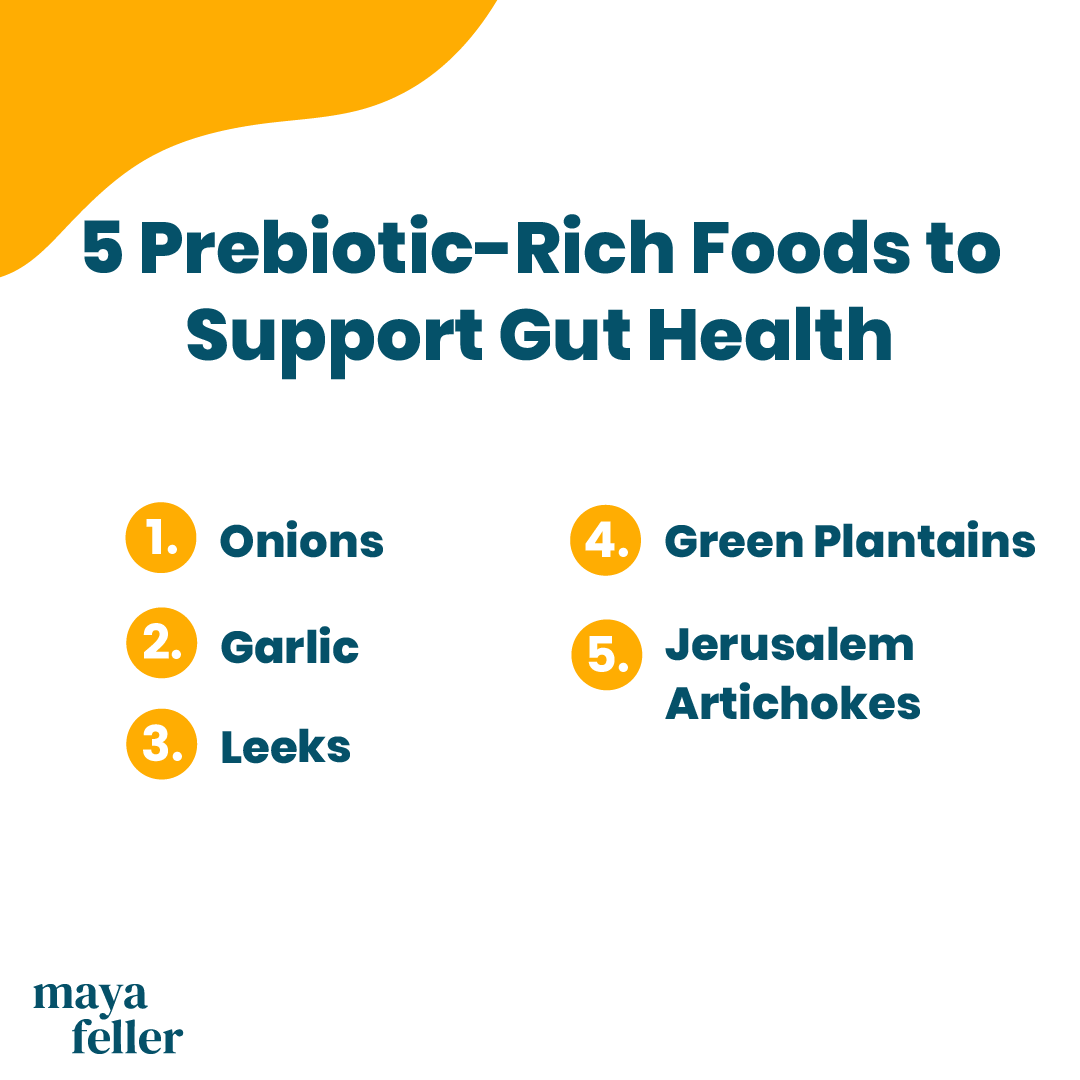Prebiotics, the carbohydrate that needs to be a part of your routine!
Want to know what makes your probiotics even more effective? Prebiotics! Now you may be wondering what prebiotics are, where to find them and what they do?
The World Health Organization defines prebiotics as “nonviable food components that confer a health benefit on the host associated with modulation of the microbiota”1. Simply put, they are the fibrous parts of plants that are indigestible and act as nourishment for the bacteria living in our gut. Prebiotic fibers pass through the GI tract in tact and ferment further down in the colon. During the process of fermentation more healthy bacteria is populated.
On the other hand, probiotics are live organisms that also provide health benefits. In essence, prebiotics are food for probiotics so they can do their job of increasing short chain fatty acids and increasing the amount of good bacteria in our gut. The combination of prebiotics and probiotics make up synbiotics, together they improve the survival of probiotic bacteria in the gut3.
Prebiotics are quite interesting as they selectively influence the bacteria living in our gut, this means they will only impact specific bacteria. All of these interactions take place in the colon. The net result is improved gut and whole-body health. 1
How do prebiotics naturally occur in food?
Prebiotics are mostly found in food sources that contain complex carbohydrates, like fiber and resistant starch. The body cannot digest these carbohydrates so they pass through the digestive system and become food for bacteria and other microorganisms in the gut3.
Foods that contain prebiotic fiber include vegetables, fruits and whole grains. Some foodswith the highest prebiotic content are onions, garlic, leeks, Jerusalem artichokes, asparagus, root vegetables, nuts, legumes, oats, and green plantains.
As mentioned previously, a combination of probiotic and prebiotic foods supports a healthy gut and this, in turn, supports immune health. A pattern of eating that centers around fruits, vegetables, whole grains, beans, nuts, seeds and fermented foods in their whole and minimally processed form will ensure synbiotics, the mixture of the two.
What are the health benefits of prebiotics?
There are many health benefits associated with consuming prebiotic fibers. Specific health benefits depend on the type of prebiotic. There are many different types of prebiotics including inulin, beta glucans, resistant starch, and more5. Beta glucans for example can support healthy cholesterol levels and resistant starches can support healthy blood glucose levels.
Prebiotic dietary fibers have a beneficial impact on the gut and increase probiotic bacteria, specifically Bifidobacteria and Lactobacili. These have many health benefits including gut health, immune health, mental health, and glucose and lipid regulation. More details can be found in our probiotic post. More research is being on edible prebiotic fibers and the role they play in IBS (irritable bowel syndrome), bone health and the absorption of calcium, immune function and health and allergies6.
So now you know more about probiotics and are ready to incorporate them into your pattern of eating. Here are 5 ways to add prebiotics to your routine!
5 Tips For Upping The Prebiotic Content Of Your Meals
Fiber, Fiber, Fiber! Most people will get some form of prebiotics when consuming fiber rich foods.
- Add onion and garlic to your favorite dishes. They are a fantastic way to add flavor without the need for added salts or synthetic fats.
- Try something new: many roots are rich in fiber, including Manioc, Chicory root, Yacon root, Jicama root, Burdock root, Konjac root.
- Try chicory root coffee, baked root veggie chips with any root vegetable, cassava pone, jicama sticks with the sauce or dip of your choice, or roasted Burdock root.
- Eat your nuts (and nut skins!)
- Make boiled chestnuts at home, or during the colder months find roasted chestnuts at a stand near you!
- Have a handful of almonds, keeping their prebiotic-rich skins on.
- Incorporate dandelion greens into your leafy green routine, or cook them for a warm salad base.
- Combine probiotic foods with prebiotic foods for a synbiotic source
- Sauerkraut and kimchi are not only fermented foods but also often include onions and garlic
- Add banana to your fermented yogurt
- Make a ramen bowl with seaweed, tempeh, and miso paste
What’s next?
For even more fiber-rich foods, check out my top 25 recommended foods and my Seamoss prebiotic smoothie for GMA.
We also recommend you to follow the latest research on prebiotics. Researchers are continually finding out more about the impact of consumption of prebiotics on human health.
If you are looking for ways to incorporate prebiotics into your pattern of eating or have a question about your gut health, visit our website to learn more about how you can work with one of our dietitians!
References
- Pineiro M, Asp NG, Reid G, et al. FAO Technical meeting on prebiotics. J Clin Gastroenterol. 2008;42 Suppl 3 Pt 2. doi:10.1097/MCG.0B013E31817F184E
- Hill C, Guarner F, Reid G, et al. The International Scientific Association for Probiotics and Prebiotics consensus statement on the scope and appropriate use of the term probiotic. Nat Rev Gastroenterol Hepatol 2014 118. 2014;11(8):506-514. doi:10.1038/nrgastro.2014.66
- Markowiak P, Ślizewska K. Effects of Probiotics, Prebiotics, and Synbiotics on Human Health. Nutrients. 2017;9(9). doi:10.3390/NU9091021
- Carlson JL, Erickson JM, Lloyd BB, Slavin JL. Health Effects and Sources of Prebiotic Dietary Fiber. Curr Dev Nutr. 2018;2(3). doi:10.1093/CDN/NZY005
- Davani-Davari D, Negahdaripour M, Karimzadeh I, et al. Prebiotics: Definition, Types, Sources, Mechanisms, and Clinical Applications. Foods. 2019;8(3). doi:10.3390/FOODS8030092
- Gibson GR, Hutkins R, Sanders ME, et al. Expert consensus document: The International Scientific Association for Probiotics and Prebiotics (ISAPP) consensus statement on the definition and scope of prebiotics. Nat Rev Gastroenterol Hepatol. 2017;14(8):491-502. doi:10.1038/NRGASTRO.2017.75


Leave a Reply